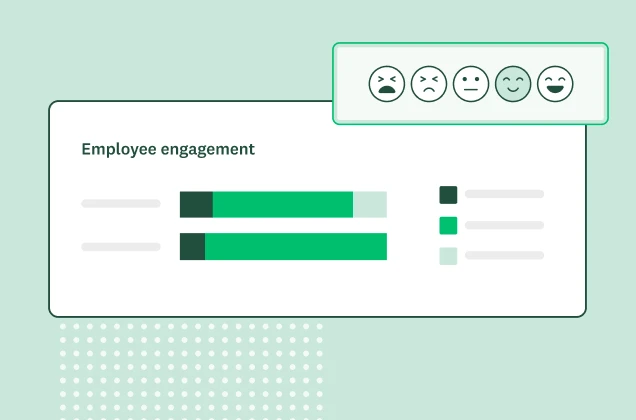Ultimate guide to DEI in the workplace
This guide contains information for understanding DEI and taking steps to drive lasting change in your organization.
Diversity, equity, and inclusion can help you build a high-performing workforce and gain a competitive advantage. According to McKinsey & Company, US companies spend $8 million each year on diversity training, yet many companies are still struggling with their DEI efforts. This guide is intended to help you increase your DEI efforts and launch a program of your own.
Get guidance from diversity and inclusion leaders
Learn how to to measure DEI in your organization from experts that are excelling in building an inclusive workforce.
What is diversity, equity, and inclusion?
Diversity, equity, and inclusion—usually called “DEI” or “DE&I”— stand for the strategies, programs, policies, and practices to create and sustain a diverse, equitable, and inclusive work environment. The terms are used together, but each has a specific meaning. All three are necessary to benefit your employees and your organization.
Each concept adds something to the overall idea:
Diversity
Diversity includes all the ways people are different, both identity-based and cognitively. Some people stop there and think that diversity is only about our differences, but in reality, diversity is about accepting and valuing those differences.
This is a brief list of common types of diversity:
- Ethnicity
- Race
- Sexual orientation
- Gender identity
- Physical ability
- Neurodiversity
- Age
- Marital status
- Religion
- Veteran status
- Education
Whether the diverse traits are visible or invisible, they exist and can add value to an organization. Your diverse workforce brings its differences to the table and influences best work practices.
Equity
Equity relates to the opportunities a person is offered regardless of circumstance. Policies and practices affecting your employees across performance management, promotions, attrition, and more need to be equitable. Equity promotes justice, fairness, and impartiality within your company, eliminates barriers, and levels the playing field
Equity and equality are not the same things
Equality means that all groups are given the same resources or opportunities. Equity recognizes that each individual has different circumstances and are provided with resources and opportunities to reach an equal outcome.
Our DEI leader explains how Workplace Equity IQ can help you fulfill your DEI commitments.
Inclusion
You might think that a diverse company with equity would naturally have inclusion. But, unfortunately, that isn’t always the case.
Inclusion is the welcoming environment supported by your company. An inclusive workplace is respectful, collaborative, and supportive, with the goal of encouraging all employees to participate and contribute.
Tip: To evaluate inclusion, start with empathy. Ask your employees how they feel about their workplace. Do they feel like they belong? Can they bring their whole selves to work? What would make them feel heard?
Belonging
Belonging is where diversity, equity, and inclusion intersect. When your work environment has all three elements of DEI, belonging is necessary to glue it all together. A sense of belonging makes each individual feel like they are part of the team—included, accepted, and valued for their authentic selves.
The EY Belonging Barometer study revealed that 34% of people feel the greatest sense of belonging at work (this is a higher percentage than their physical neighborhood at 19% and place of worship at 17%).
Access pre-written survey templates for measuring diversity, equity, and inclusion in your organization.
The power of DEI in the workplace
There are definite positive effects in companies that embrace DEI, but your efforts need to be supported by your entire organization to be successful. Employees, mid-level managers, and leaders all need to understand the benefits and support DEI efforts for maximum advantages.
Here are just a few of the benefits of a diverse, equitable, and inclusive workplace:
Larger talent pool
With DEI in mind, you will have a larger pool of top talent to choose from for your company. And with a strong program in place, your business will appeal to a broader group of applicants. Glassdoor’s 2020 Diversity and Inclusion Workplace Survey found that 76% of job seekers and employees report that a diverse workforce is important when evaluating companies and job offers.
Increased employee engagement
Employee engagement is an important factor in business success. Engaged employees have better attendance, increased productivity, less turnover, and fewer safety incidents. This results in an increase in profitability and customer loyalty for the company.
More opportunities for innovation
Diverse, equitable, and inclusive companies have more opportunities for innovation as employees from different backgrounds with a variety of skills and experiences bring their uniqueness to the table.
Improved decision-making
According to Deloitte Insights, cognitive diversity can enhance team innovation by up to 20%. It drives faster problem solving and better decision-making. To further that, Forbes research indicates:
- Inclusive teams make better business decisions up to 87% of the time
- Teams that follow an inclusive process make decisions two times faster with half the meetings
- Decisions made and executed by diverse teams delivered 60% better results
Increased employee retention
This study by Momentive, maker of SurveyMonkey, demonstrates that employees are very invested in companies’ DEI efforts. A full 78% of the workforce says it’s important to work for an organization that prioritizes diversity and inclusion. There is a strong correlation between job satisfaction and DEI and to retain employees, you’ll need to ensure that you are meeting expectations with your DEI initiatives.
Improved financial performance
The most diverse companies are more likely to outperform non-diverse companies in profitability. McKinsey claims that their analysis also found that companies in the top quartile of gender diversity on executive teams were 25% more likely to experience above-average profitability.
As you might expect, companies in the fourth quartile of both gender and ethnic diversity are more likely to underperform (by 27%) on profitability.
Remain competitive in the market
Consider the products you offer. How are they presented? Do they represent your DEI policies? For example, if you’re an apparel company, do you provide unisex styles in addition to men’s and women’s? Do you offer a full range of sizes and fits for all body types? Do your sales and marketing materials reflect DEI?
A diverse marketing team can steer the conversation and advocate for inclusivity in your messaging.
How to create a DEI strategic plan
Creating a DEI plan is more than an HR initiative. It needs to be a formalized framework that is included in your company’s mission, values, and strategies in ways that are transparent throughout your business. You’ll need specific plans and programs, along with measurement and monitoring to evaluate success and identify areas in need of improvement.
These steps will help you get started:
Do your homework
Before embarking on creating your DEI strategic plan, do some research. Learn about diversity, equity, and inclusion history, background, and context.
These articles and websites are great places to start:
- SurveyMonkey reveals how it cultivates DEI
- This LinkedIn article discusses the evolution of diversity in the workplace
- DiversityInc offers myriad information about best practices and current topics in DEI
- Fast Company presents its take on DEI training
Analyze your data
Once you understand where DEI has come from and how it is evolving, it’s time to look at your own company. Our employee survey solutions can measure everything from demographics to engagement levels to inclusion and belonging. Be sure to include everyone in your research, including managers and C-suite executives. The data you collect will guide you in creating your DEI initiatives.
When it comes to DEI, the data you capture should be more than just survey responses from employees. Companies also need to be tracking and analyzing attrition data, promotional data, hiring trends, sentiment on social media and review sites, and many other business success metrics that can help tell a story about who you are as a company.
Set key performance indicators (KPIs)
Depending on where your data indicates your company needs improvement, you’ll determine KPIs for measuring your progress toward your DEI goals.
Some examples of HR KPIs include:
- Diversity of hiring pool - Are you attracting candidates from various backgrounds, races, genders, etc.?
- Employee retention - Are employees from certain groups leaving at a higher rate than others?
- Employee promotion - Is there a lot of demographic similarity among the employees who are getting promoted?
- Employee engagement - Which employees indicate high levels of satisfaction? Is the company culture healthy or are microaggressions an issue?
- Company representation - Is there diversity in your company leadership?
These are a few examples of metrics you may choose to monitor. Once you have put together your KPIs, publish your results. Transparency of your progress towards your DEI initiatives holds you accountable and demonstrates your internal and external commitment to DEI.
Settling HR KPIs, analyzing the data, and looking for outliers or trends can help you understand where equity in your company really stands. For example, just because you may have hired a diverse pool of employees doesn’t mean those employees feel they belong, or that their promotions are equitable. It’s important to look at each of these areas separately to establish baselines and collectively to meet goals.
Hire for culture contribution rather than fit
Traditionally, companies hire for culture fit. Challenge the norm and recruit new employees for culture contribution. Seek out employees whose values align with those of your company by bringing their unique experiences, backgrounds, and perspectives.
Make DEI part of your core
Put your diversity, equity, and inclusion statement in writing. Share it on your company’s website, in public relations’ efforts, on social media posts, in job descriptions, and more. Ideally, your statement should include:
- Your company’s mission
- Your commitment to diversity
- Language that is inclusive
- Language that is positive
- Mention of traditionally marginalized groups
- Clarity, with words that are recognizable and easy to understand
Read our DEI statement and our commitment to help shape a better world.
How to promote DEI
Over the last several years, there has been a lot of progress in workplace DEI. However, recent social, cultural, and health events have highlighted the fact that we still have further to go.
Here are some ways you can promote DEI in your workplace:
Make DEI a priority
Your goals for DEI are as important as your other company goals. Make those goals a priority, take action, and measure results. DEI should have the full attention of upper management and should be monitored closely, reported on, and discussed regularly.
Facilitate employee feedback
Employee feedback is the best way to discover what’s working and what isn’t in your company. Try our diversity and inclusion survey templates as a starting point, and customize them to work for your company goals.
Momentiven offers a Guided Employee Experience that uses AI-powered technology to help you foster inclusion in your workforce.
Support open communication
Provide a culture of trust where employees can voice concerns and opinions safely. Whether you use an intranet solution, forum, or Slack channel, connect with your employees to find out what you can do to improve their experiences within your organization.
Strengthen policies
Ensure that policies are clear and transparent. This is a key step in impacting DEI. For example, ensure that the policies to report microaggressions, bias, and harassment are clear and understood by all—and applied consistently. Other policies to review and update include work-from-home, parental leave, and work-life sustainability.
Measuring DEI
We briefly discussed measuring DEI when we mentioned KPIs. Those are the metrics that you will use to measure the ongoing status of your DEI progress toward goals. Create a DEI scorecard and review your goals and metrics on a regular basis.
You’ll use different metrics for different purposes. Here’s an overview of the metrics you’ll use to measure DEI in your organization:
- Representation measures the percentage of employees from traditionally marginalized groups compared to industry standards and company benchmarks.
- Retention identifies the average tenure for a group of employees as compared to other employees at the company.
- Recruitment identifies barriers to entry for different groups and biased recruitment practices.
- Selection identifies biases in the selection process.
- Promotion tracks promotions across groups of employees, including the time to progress.
- The pay metric measures any compensation bias.
- Development ensures a position has room for professional development.
- Employee engagement may be used to indicate biased mindsets.
- Diversity
- Primary: age, gender identity, race, and sexual orientation
- Secondary: education, marital status, parental status, religion
- Workplace: job level, work shift, number of years with company
- Style: work habits, leadership style, communication style
Decide which metrics best meet your company goals, gather baseline metrics, analyze your results, create an action plan, and continuously measure progress.
Your measurements will be used to identify areas of risk, set program goals, prioritize initiatives, assign accountability, and measure how well your initiatives are working.
DEI and your company
DEI is critical for your employees and your company. It’s time to measure the baselines and set goals to improve diversity, equity, and inclusion now.
Explore SurveyMonkey for DEI and all of your marketing and research solutions. Contact us today to get started!
리소스 더 살펴보기

인적 자원 리더
HR 리더는 이 도구 키트를 사용하여 탁월한 직원 경험을 주도할 수 있습니다.

온라인 고용 양식으로 필요한 직원 정보를 얻으세요
맞춤 고용 양식으로 최고 인재를 채용하고 온보딩 절차를 가속화하며 인력을 관리할 수 있습니다. 고용 양식 작성기와 템플릿으로 지금 양식을 만들어 보세요.

온라인 평가 양식을 통해 행동으로 옮길 수 있는 피드백을 받아보세요
SurveyMonkey의 온라인 평가 양식을 통해 피드백을 백분 활용하세요. 오늘 문의 양식 템플릿을 시작하세요!

How to make a quiz online: Examples, tips, and best practices
Make a quiz online by following these 10 steps. Following these tips will take you from scratch to having a fully functioning online quiz.